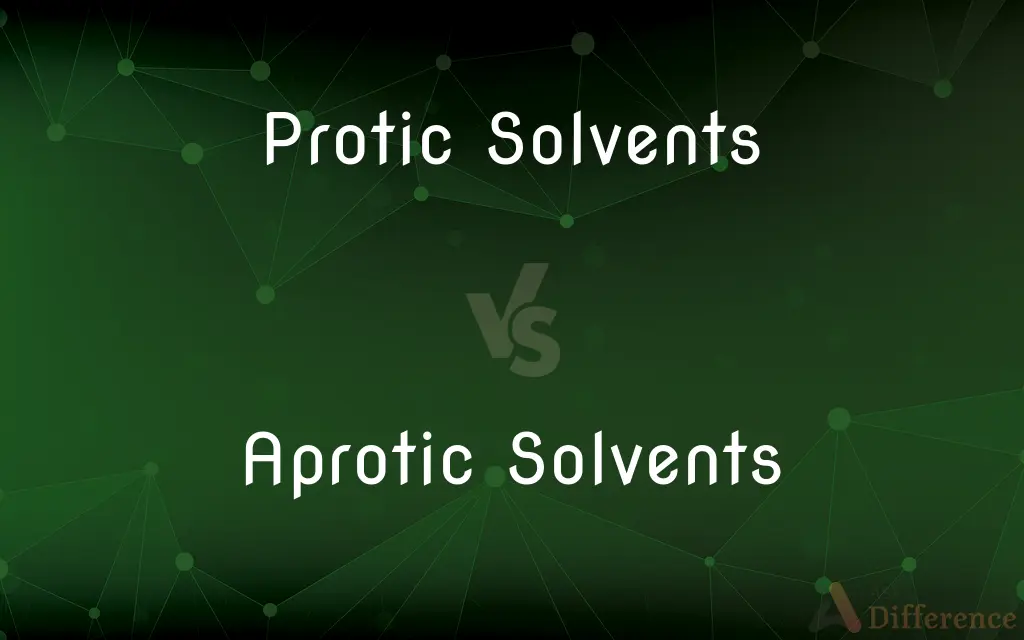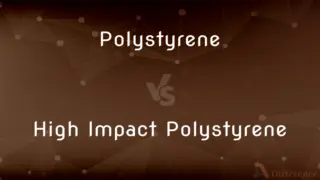Protic Solvents vs. Aprotic Solvents — What's the Difference?
Edited by Tayyaba Rehman — By Fiza Rafique — Published on February 22, 2024
Protic solvents, able to donate hydrogen bonds, include water and alcohols, aiding in solvation through hydrogen bonding, while aprotic solvents, unable to donate hydrogen bonds, dissolve substances through dipole interactions without hydrogen bonding.

Difference Between Protic Solvents and Aprotic Solvents
Table of Contents
ADVERTISEMENT
Key Differences
Protic solvents are characterized by their ability to donate hydrogen atoms in hydrogen bond formations, a property that significantly influences their solvation capabilities. Common examples include water, methanol, and ethanol. These solvents are particularly effective in stabilizing ions and solutes through hydrogen bonding, making them ideal for reactions involving proton transfer or where strong solvation is needed.
Aprotic solvents, on the other hand, cannot donate hydrogen atoms for hydrogen bonding but can accept them. Examples include dimethyl sulfoxide (DMSO), acetone, and dichloromethane. Their lack of hydrogen bonding capability does not impede their ability to dissolve a wide range of substances; instead, they rely on dipolar interactions and van der Waals forces to solvate solutes, particularly useful for reactions involving anions as they can enhance nucleophilicity by not solvating anions as strongly as protic solvents.
The choice between protic and aprotic solvents can significantly affect the outcome of chemical reactions. Protic solvents are often used in acid-base reactions due to their ability to participate in hydrogen bonding, which can stabilize reactive intermediates. In contrast, aprotic solvents are preferred in nucleophilic substitution reactions where the strength of the nucleophile is a critical factor.
The polarity of the solvent also plays a crucial role in determining its suitability for various reactions. Protic solvents are generally polar and can dissolve ionic compounds effectively. Aprotic solvents can be polar or non-polar, but even polar aprotic solvents do not engage in hydrogen bonding, which influences their interactions with solutes and ions differently from protic solvents.
Environmental and safety considerations also differ between the two types of solvents. Protic solvents like alcohols are relatively benign, but some, like methanol, can be toxic. Aprotic solvents range widely in their safety profiles, with some, like DMSO, being biologically safe, while others, like dichloromethane, are hazardous due to toxicity and volatility.
ADVERTISEMENT
Comparison Chart
Hydrogen Bonding
Can donate hydrogen atoms for bonding
Cannot donate hydrogen atoms for bonding
Examples
Water, methanol, ethanol
Acetone, DMSO, dichloromethane
Solvation Mechanism
Stabilize solutes through hydrogen bonding
Solvate via dipole interactions and van der Waals forces
Common Uses
Acid-base reactions, where hydrogen bonding stabilizes intermediates
Nucleophilic substitutions, enhancing nucleophile strength
Polarity
Generally polar
Can be polar or non-polar
Compare with Definitions
Protic Solvents
Generally polar, dissolving ionic substances.
Methanol dissolves salts due to its polar nature.
Aprotic Solvents
Enhance nucleophilic reactions.
DMSO is chosen for its ability to solvate cations without affecting anions.
Protic Solvents
Can participate in hydrogen bonding.
Acetic acid, a protic solvent, forms hydrogen bonds with solutes.
Aprotic Solvents
Rely on dipole interactions for solvation.
Dichloromethane dissolves substances through its dipolar nature.
Protic Solvents
Often used to stabilize ions.
Ethanol, a protic solvent, is effective in solvating ionic compounds.
Aprotic Solvents
May be polar or non-polar.
Tetrahydrofuran (THF) is a polar aprotic solvent used in Grignard reactions.
Protic Solvents
Suitable for reactions needing proton donors.
Protic solvents like formic acid facilitate proton transfer.
Aprotic Solvents
Preferred for sensitive nucleophilic substitutions.
N,N-Dimethylformamide (DMF) is used in SN2 reactions.
Protic Solvents
Solvents that can donate hydrogen for bonding.
Water acts as a protic solvent in acid-base reactions.
Aprotic Solvents
Cannot donate hydrogen for bonding.
Acetone, an aprotic solvent, is used to dissolve organic compounds.
Common Curiosities
What is the significance of solvent polarity in reactions?
Solvent polarity affects the solubility of reactants and products and can influence reaction mechanisms and outcomes.
Are all polar solvents protic?
Not all polar solvents are protic; polar aprotic solvents have dipole moments but cannot donate hydrogen for hydrogen bonding.
Why are aprotic solvents important in organic synthesis?
Aprotic solvents can enhance the reactivity of nucleophiles and are essential in reactions where strong solvation of anions by the solvent is undesirable.
Why might an aprotic solvent be chosen for a nucleophilic substitution reaction?
Aprotic solvents do not solvate anions strongly, making nucleophiles more reactive and improving the efficiency of nucleophilic substitution reactions.
What makes a solvent protic?
A protic solvent has hydrogen atoms bound to electronegative elements like oxygen or nitrogen, allowing it to participate in hydrogen bonding.
Can a solvent be both protic and aprotic?
No, solvents are classified as either protic or aprotic based on their ability to donate hydrogen atoms for hydrogen bonding.
Can aprotic solvents be used with ionic compounds?
While aprotic solvents can dissolve ionic compounds, their ability to do so may be less compared to protic solvents due to the lack of hydrogen bonding.
Can the choice of solvent affect reaction rate?
Yes, the solvent can significantly impact reaction kinetics, especially in processes where solvation or solvent reactivity plays a key role.
How do protic solvents stabilize ions?
Protic solvents stabilize ions through hydrogen bonding, which can solvate and stabilize both cations and anions.
Are protic solvents always safe to use?
While many protic solvents are relatively safe, some, like methanol, can be toxic, and their use requires appropriate safety measures.
How does solvent choice affect solubility of solutes?
The solvent's polarity and ability to form hydrogen bonds influence its ability to dissolve various solutes.
What role do protic solvents play in acid-base chemistry?
Protic solvents can act as acids or bases in proton transfer reactions, making them essential in acid-base chemistry.
What considerations should be made when selecting a solvent for a reaction?
Considerations include the solvent's polarity, reactivity, toxicity, boiling point, and its effect on the reaction mechanism and rate.
Do aprotic solvents have any environmental concerns?
Some aprotic solvents, due to their toxicity and volatility, pose environmental and health risks and require careful handling and disposal.
How do solvents influence the energy barrier of a reaction?
Solvents can stabilize or destabilize transition states and intermediates, affecting the activation energy and overall rate of the reaction.
Share Your Discovery

Previous Comparison
SLST vs. IST
Next Comparison
Polystyrene vs. High Impact PolystyreneAuthor Spotlight
Written by
Fiza RafiqueFiza Rafique is a skilled content writer at AskDifference.com, where she meticulously refines and enhances written pieces. Drawing from her vast editorial expertise, Fiza ensures clarity, accuracy, and precision in every article. Passionate about language, she continually seeks to elevate the quality of content for readers worldwide.
Edited by
Tayyaba RehmanTayyaba Rehman is a distinguished writer, currently serving as a primary contributor to askdifference.com. As a researcher in semantics and etymology, Tayyaba's passion for the complexity of languages and their distinctions has found a perfect home on the platform. Tayyaba delves into the intricacies of language, distinguishing between commonly confused words and phrases, thereby providing clarity for readers worldwide.














































